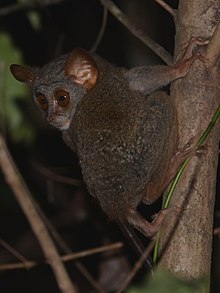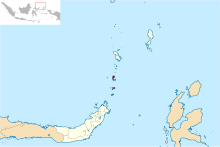Siau Island tarsier
| Siau Island tarsier | |
|---|---|

| |
| Scientific classification | |
| Domain: | Eukaryota |
| Kingdom: | Animalia |
| Phylum: | Chordata |
| Class: | Mammalia |
| Order: | Primates |
| Suborder: | Haplorhini |
| Family: | Tarsiidae |
| Genus: | Tarsius |
| Species: | T. tumpara
|
| Binomial name | |
| Tarsius tumpara | |

| |
The Siau Island tarsier (Tarsius tumpara) is a species of tarsier from the tiny volcanic island of Siau in Indonesia.[2] The T. tumpara species is one of 14 species and 7 subspecies in the tarsier family called "Tarsiidae".[3] They belong to the Haplorrhini suborder, known as the "dry-nosed" primates.[3] The tarsier's eyes are so big that they do not move in its socket and they are almost as big as its brain.[3] The name tumpara, which means tarsier in the local language of Sulawesi,[clarification needed] was an attempt to encourage the community in preserving this biological heritage.
Characteristics
Anatomy and physical appearance
The main characteristics of the tumpara tarsiers include having a white ventral fur, lacking the distinctive golden dorsal fur of the
Eyes
The Siau Island tarsier has very big eyes that do not move, and have very big irises that range in shades of gold and brown. The size of its eyes helps the species with nocturnal vision. They have foveal vision, which helps them to see things more sharply. However, they lack a tapetum (which is very common in mammals).[3]
Agility
Siau Island tarsiers are an arboreal species, which means they spend most of their time in trees, and therefore are very agile and excellent at jumping and climbing.[3] They can jump up to 10 ft (3 m) high, have a neck that turns 180 degrees, and have good hearing.[3] They also have long thin fingers which helps them to grab things such as when they are capturing prey.[3] The T. tumpara's main method of hunting consists of sitting quietly on a branch and waiting for a prey to arrive to attack it.[3]
Reproduction
Siau Island tarsiers can reach sexual maturity at two years old, this means that they carry and give birth to an offspring.[3] Pregnancy lasts around six months and the mother gives birth to a single offspring.[3]
Nutrition
They are a carnivorous species that feed on small animals such as frogs, lizards and small birds, but mostly eat insects like spiders.[3][4] They have a very wide mouth, strong jaw and sharp teeth which help them feed off small animals.
Geography
Tarsiers are found in Southeast Asia, though the T. tumpara is endemic to Siau Island, Indonesia.[5] This species was located geographically using GIS and geographic profiling and they have found that they live in a small range of 125 km, with an even smaller occupancy range of approximately 19.4 km.[6][7] The tumpara tarsier species has a population of approximately 1,358–12,470 and is declining due to the many threats they face.[4]


Habitat
The tarsier species are nocturnal and can be found sleeping in tree holes during the day, especially those of fig trees (Ficus), depending on what forest they are in.[6] They can usually be found entering their trees to go sleep between 5:00 AM and 6:00 AM.[6] The members of each group sleep individually in their own trees to avoid a predator attack on the entire family.[3]
Taxonomy
Its existence as a distinct taxon was predicted by the hybrid biogeographic hypothesis for

It was furthermore elaborated upon that the original description of T. sangirensis included mention of a specimen from Siau in the Dresden Museum. Thus it was argued for further investigations of the Siau tarsier to see if it was taxonomically separable from T. sangirensis.[9]
Conservation
The
Predators
The species primary predators are humans, arboreal snakes, lizards, birds of prey and feral cats.[15] However, their cryptic behaviour makes it difficult for predators to catch them.[6]
References
- . Retrieved 12 November 2021.
- S2CID 55493260.
- ^ a b c d e f g h i j k l m n o p q "Siau Island Tarsier | New England Primate Conservancy". 2021-12-16. Retrieved 2022-04-11.
- ^ S2CID 32358378.
- ^ "tarsier | Description, Species, Habitat, & Facts | Britannica". www.britannica.com. Retrieved 2022-04-12.
- ^ doi:10.1111/jzo.12203 – via ZSL.)
{{cite journal}}: CS1 maint: multiple names: authors list (link - ^ S2CID 55493260.
- ^ a b Shekelle, M.; Leksono, S. M. (2004). "Rencana konservasi di Pulau Sulawesi: dengan menggunakan Tarsius sebagai flagship spesies (Conservation strategy in Sulawesi Island using Tarsius as flagship species)". Biota. 9 (1): 1–10.
- S2CID 29045930.
- S2CID 31273860.
- ISBN 978-1-934151-34-1. Archived from the original(PDF) on July 23, 2011.
- S2CID 31273860.
- ^ S2CID 8260464.
- ^ Supriatna, Jatna; Winarni, Nurul L.; Dwiyahreni, Asri A. (2015). "Primates of Sulawesi: An Update on Habitat Distribution, Population and Conservation". Taprobanica. 07: 170–192.
- ^ "Tarsier". Wisconsin National Primate Research Center. Retrieved 2022-04-12.
Further reading
- Shekelle, M.; Salim, A. (2009). "An acute conservation threat to two tarsier species in the Sangihe Island chain, North Sulawesi, Indonesia". Oryx. 43 (3): 419–426. .
External links
- Siau Island tarsier (Tarsius tumpara) media from ARKive


